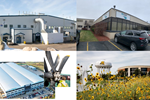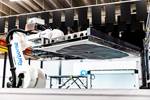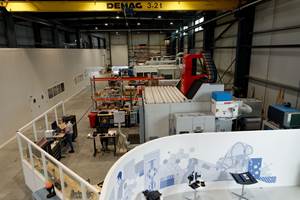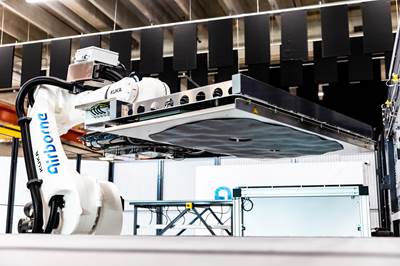
Teijin's 185,000-square-foot carbon fiber production facility in Greenwood, South Carolina, occupies 12 acres of an expansive 440-acre property, offering ample room for growth. Source (All Images) | Teijin
In 2001, Greenwood, South Carolina, was one of the most economically depressed counties in the U.S. By 2007, six major textile mills in the area ceased operations. The median income plummeted by nearly 28%, and poverty levels in Greenwood County had doubled within a short 3-year span.
During this time, Teijin Ltd. (Tokyo, Japan), a global advanced materials company, was searching for a site for a new U.S.-based carbon fiber production facility. The company previously had a Tenax carbon fiber line based in Rockwood, Tennessee, that was eventually converted to production of the company’s Pyromex oxidized polyacrylonitrile (PAN) fiber used in flame-resistant insulation, carbon/carbon brakes and gas diffusion layers for fuel cells. After a number of years, increasing export challenges and shipping logistics motivated the company to invest in a new U.S.-based facility dedicated to Tenax structural carbon fiber.
With 20 potential sites initially under consideration, the focus soon narrowed to six options based on crucial factors such as access to utilities, skilled labor, infrastructure and governmental support at the state and local levels. “These sites were nearly identical in what they offered us. We chose Greenwood because it was a place where we felt we could make a significant impact on the community and operate efficiently,” says Aaron Buchok, business development manager for Teijin Carbon America Inc. (Greenwood, S.C., U.S.). The site also offered a talent pool of people with textiles training as well as rail access to Atlanta, Charlotte and the ports of Charleston and Savannah, providing shipping and logistical advantages.
Room for growth
In addition to these benefits, the site in Greenville County, at approximately 440 acres, also offered plenty of room for future expansion. Teijin envisioned multiple carbon fiber lines , including the production of precursor materials, thereby ensuring self-sufficiency in the manufacturing process at this facility.
While PAN precursor for the Greenwood plant is currently imported from Teijin’s Mishima plant in Shizuoka Prefecture, Japan, the company says that with sufficient growth in the market, such a line could possibly be part of future expansion at Greenwood.
“The site was selected specifically for our ability to expand it,” says Buchok. “We have sufficient room to support multiple carbon fiber lines here, as well as precursor — so we could make our own feedstock here as well.”
Teijin purchased the property in 2017, and with help from the state of South Carolina expect to create 220 full-time positions by 2030. The company broke ground on the new facility in June 2018 and today the 185,000-square-foot Greenwood plant occupies a little over 12 acres of the expansive property. Its operational carbon fiber lines have been producing materials for almost two years, serving industries ranging from aerospace to automotive.
“We’re making sellable material today,” says Buchok. “Much of that capacity goes to supporting our prepregging customers or customers who will weave them into dry textiles.”
Currently, the Greenwood facility is producing industrial- and aerospace-grade 12K and 24K fibers in standard and intermediate modulus formats. Buchok says the company has done preliminary work to bring high modulus fiber to the plant as well.
“Initially, it was almost 100% industrial,” he says. “In our industry, we have to earn our way into an aerospace rating, and we do that by demonstrating stable output over the course of a number of production runs. Once we’ve exceeded that number, then we’re allowed to market that to an aerospace customer base. Our focus during that first year is on completing that demonstration of our ability to produce materials at the quality and consistency that the aerospace customer base expects.”
The plant’s standard modulus fibers have been at aerospace grade for a little over a year now. While Teijin will not divulge the exact production numbers for the South Carolina plant, it is said to be similar to the 2,700 metric tonne/year line added to its Mishima Plant in Japan in 2008.
An eye on the hydrogen market
Teijin’s vision for growth is based on the company’s strategic alignment with emerging markets, an example of which is in hydrogen energy storage. As the demand for hydrogen-powered vehicles and industrial applications surges, the Greenwood site offers the flexibility to cater to the evolving needs of customers.
“Today, we see automotive manufacturers already putting hydrogen vehicles on the ground,” says Buchok. “We’ve got ground-based Type 4 hydrogen storage facilities for industrial applications already out in the world. This is real, and it’s going to heavily influence the composites market for at least the next decade.”
How Teijin is positioning itself to serve this market has played into the design of its Greenwood plant. Pressure vessel manufacturers for hydrogen applications generally prefer to work with larger tows — 12K, 24K and higher — which enable them to build composite storage tanks faster using less manpower and less machine time. The Greenwood plant is specifically built around larger tow sizes —12K and above — which helps position the company as a frontrunner for providing materials to the hydrogen energy sector in the near future.

The facility’s exhaust stacks are routed back into an air filtering system for processing.
Building on experience
Walking from Teijin’s Greenwood offices to the plant, the size of the property is readily apparent. The facility is surrounded by fields and woods, and Teijin manages a registered wetland area on the site. Employees frequently encounter deer grazing in areas between the buildings. “We have a very strong wildlife population here that we are obligated to make sure we’re treating responsibly,” Buchok says.
Teijin takes its stewardship of the property very seriously. Buchok says the site was chosen with the intent to manage it in a sustainable and responsible manner. The company drew on the best of its facility designs held internationally in terms of operational output, robustness and sustainability.

Wastewater is captured and reused in industrial processes. What can't be reused is removed from the site for EPA-compliant disposal.
The facility’s wastewater is also captured and treated with the same care. Teijin recycles as much water as it possibly can from the facility for reuse in its industrial processes. What can’t be reused is collected on site for EPA-compliant disposal. None is released into the surrounding environment.
Entering the plant, Buchok reiterates that Teijin designed the Greenwood plant based on a similar structure to its facilities overseas, looking to its plants in Germany and Japan for lessons learned and where they might be applied. One example is the eventual adoption of new technology aimed at reducing energy consumption for carbon fiber conversion, originally developed in another facility. A team has been dispatched to gather insights from that location, with plans to eventually implement the same technology in Greenwood, likely within the next 3-4 years.
The shared architectures and processes among Teijin’s plants facilitate swift translation of innovations. In many ways, the Greenwood facility represents the culmination of the company’s past efforts and the hope is that future iterations will surpass current standards, leading to continuous improvement in subsequent production.
Teijin’s carbon fiber manufacturing is fully certified under ISCC International Sustainability & Carbon Certification (ISCC), a sustainability in manufacturing certification that ensures that there is complete traceability at all stages of the manufacturing process of a product. Each of Teijin’s processes has met the expectations of the ISCC certification process from precursor manufacturing all the way through delivery.
“All of that was integrated into this site when we built it,” says Buchok. “It has full energy monitoring capabilities. We can run high-fidelity life cycle analyses. We can tell you in highly precise levels, what our emission and energy consumption is from this facility as a function of which product we’re making.”
Buchok says those tools enable the plant to determine the full impact of any process changes from an energy consumption perspective, which ultimately translates into sustainability and cost.

The carbon fiber precursor makes multiple trips through an oxidation oven. Upon exiting the oxidation stage the yarn is purely comprised of carbon.
Oxidation
Up three flights of stairs, the carbon fiber production starts with large creels of PAN precursor — the primary precursor used in the production of carbon fiber due to its exceptional strength and heat resistance. The fibers are drawn through a series of oxidation ovens to remove any solvents or impurities.
By the time the PAN exits the first oxidation oven, oils have been removed and it has converted to a golden amber color. As the PAN proceeds through additional chambers, the fiber is continuously oxidized and purified , removing anything that is not carbon. In the oxidation process, the strands of fiber make multiple trips back and forth — with each cycle further “cooking” the fiber and gradually darkening it. The fiber is routed through another set of ovens before it is fully oxidized.
Buchok says the oxidation stage is really where the art and science comes into play, with everything past the oxidation steps being a fairly well established process. “This is where everybody has their secret sauce, and they put their own personal spin on it,” he says.
He goes on to explain that oxidation procedures vary slightly from manufacturer to manufacturer, which leads to variation in the performance of different carbon fibers on the market. Teijin specifically engineers its precursors to work in conjunction with its oxidation processes.
By the time the yarn exits the fifth oxidation oven, it is fully darkened and chemically refined. The later steps of the process use high-temperature furnaces and controlled tension to build and refine the microstructure, or arrangement, of the carbon atoms.
Given the exothermic nature of carbon fiber production, Buchok is quick to point out some of the safety measures that Teijin has in place. “As we ixuduze [the fibers], they release more energy than we put in,” he says. “With that comes a reasonable risk for fire. All of these ovens are designed with fire sensors inside of them. If it detects that there’s a problem with that fiber at all — if any fiber starts to glow like an ember — it will trigger a three-stage fire system which includes fire curtains, a fog system and a water deluge system.”
He also points out disposal chutes for smaller broken fibers. Outside the atmosphere of the ovens, the still-reacting fibers can potentially burst into flames. Operators place these broken strands into the disposal chutes which douse them in water, extinguishing them. The fibers then fall to a collection bin in the basement of the plant to be disposed of later or to be recycled.
Finishing the tour through the oxidation stages, Buchok explains how technicians deal with any broken yarns at any given stage of the process. A break in one of the strands will trigger alarms that migrate from zone to zone until the operator locates the break, ties it off, restrings it and then tracks the yarn all the way through the process. In accordance with Teijin’s zero waste goal, these shorter yarns are collected and sorted for smaller spools, short bobbins and even chopped products for secondary revenue streams.

During the carbonization phase, carbon fibers are subjected to extreme heat and tension to arrange their microstructure for enhanced mechanical performance.
Carbonization
After oxidation, is the demarcation point between ovens and furnaces. The oxidized fibers will now be refined via carbonization in specialized furnaces at temperatures exceeding 1500°C in a controlled inert atmosphere (nitrogen or argon, depending on the product being run). This atmosphere prevents combustion and ensures the carbon fiber does not bond with outside elements. During this phase, the yarns undergo a series of chemical reactions that transform them, arranging their microstructure for mechanical performance.
At this stage, the fiber is processed at different speeds, different temperatures and different tensions depending on the product being run on the line. Fibers are bundled together in a tighter configuration as they enter the carbonization furnace, allowing for a smaller footprint that translates to energy savings.
Buchok says the similar furnace designs are used in each of Teijin’s facilities, allowing for redundancies and sourcing of spare parts from other locations.

Upon exiting the carbonization furnaces, carbon fiber is routed through a sizing station and then on to final inspection.
Surface treatment and sizing application
As the fibers exit the carbonization furnaces, rollers guide them apart from their tightly bundled configuration, through a water bath to wash the fiber and then through a drying oven.
At this stage, the carbon fibers undergo surface treatment to improve handling during composite fabrication, and to enhance adhesion, mechanical properties and compatibility with various resin systems. Teijin maintains a catalog of dozens of different sizings and finishes to meet its customers’ different needs.
The Greenwood plant features two sizing stations to minimize and even eliminate downtime whenever a sizing change is required. Operators are even able to change sizing midstream if needed. At the end of the sizing station, an oven provides thermal treatment for certain sizings. While it isn’t a frequent requirement, it is an important one — for example, many pressure vessel applications require sizings that need this treatment.

Each bobbin is inspected and weighed prior to packaging.
Inspection, winding and packaging
Once the carbon fibers are processed and treated, they are routed back up a level for quality inspection, which is performed using optical cameras as well as visual inspection. Each yarn that goes through the process is traceable from the individual spindle back to its precursor batch, enabling Teijin to track any problems back to the source and easily identify any other affected products.
From there, carbon fiber is fed back down a level and is ready to be wound onto bobbins and packaged. The Greenwood facility has a fully automated inspection and packaging line. Teijin’s winders are set up to automatically change to a fresh spool when a bobbin is full. The plant has standard packaging of 3, 6 and 8 kilograms per bobbin and the capability to rewind as needed.

A robot packs spools of carbon fiber into cartons for shipping.
Each bobbin is then visually inspected for package integrity. From there, it goes through a number of stations. First, a barcode with traceability information is applied to the spool — the same barcode is applied to the core earlier in the process. Next, it moves to an automated scaling system to be weighed. Here, computers will extrapolate and record the weight — every spool is provided to the customer with the actual weight of carbon fiber on it. In the final step, spools are shrink wrapped and prepared for shipping.

An operator visually inspects a carbon fiber sample from a production run.
In the lab
The last stop on the tour is back up to the third level where the facility’s laboratory is located. A computer system downstairs keeps track of all the spools that are produced and randomly assigns spools to be pulled for testing. The system is programmed to pull samples based on knowledge of the customer’s requirements and will designate a determined number of rolls at the head and tail of each run for testing.

Samples from the production run are tested for density.
A number of evaluations are performed using a combination of chemical and physical testing. The yarn is tested for weight and density. The sizing chemistry is also checked by using a solvent to take the chemistry back off. The naked fibers are weighed to extrapolate how much sizing was actually added during the process and compared to the prescribed amount. The lab is also equipped with a small impregnation line, enabling specimens to be wetted out with epoxy resin for mechanical testing.
Teijin tends to sample more heavily at the start of a run to make sure its equipment is dialed in correctly before committing to the full production run. Results are compared against a database where customer certifications are stored, making it easy for quality control technicians to assess a batch and certify it for shipment to the customer.
Looking to the future
As Teijin looks to expand its operations at the Greenwood site, the company is very measured in its approach, prioritizing efforts to minimize its carbon footprint while maximizing operational efficiency. “We’ve built this plant to be able to take advantage of every lesson that we’ve learned throughout our global infrastructure,” emphasizes Buchok.
With this first phase of its Greenwood facility fully operational, Teijin is charting an ambitious course to help ensure a steady supply of carbon fiber for both current and emerging markets, reduce the company’s environmental impact and align with increasingly stringent global environmental regulations.
Buchok says the site is capable of handling more than half a dozen carbon fiber lines along with facilities for research and raw materials manufacturing, all of which are part of Teijin’s goals. “That’s probably a plan measured in decades,” he says.
Related Content
Plant tour: Joby Aviation, Marina, Calif., U.S.
As the advanced air mobility market begins to take shape, market leader Joby Aviation works to industrialize composites manufacturing for its first-generation, composites-intensive, all-electric air taxi.
Read MorePlant tour: Daher Shap’in TechCenter and composites production plant, Saint-Aignan-de-Grandlieu, France
Co-located R&D and production advance OOA thermosets, thermoplastics, welding, recycling and digital technologies for faster processing and certification of lighter, more sustainable composites.
Read MorePlant tour: Albany Engineered Composites, Rochester, N.H., U.S.
Efficient, high-quality, well-controlled composites manufacturing at volume is the mantra for this 3D weaving specialist.
Read MorePlant tour: Avel Robotics, Lorient, France
From AFP hydrofoils to more efficient aircraft parts, Avel uses digital design, multiprocess production and a rule-breaking approach for complex 4D composites.
Read MoreRead Next
Inside Teijin’s thermoplastic tape expansion
Teijin is qualifying its second thermoplastic tape line in Heinsberg, Germany, that will significantly expand the company’s presence in this material segment.
Read MoreCompositesWorld's top ten plant tours of all time
The editors at CW have been lucky enough to visit many unique facilities over the years. These tours have provided an in-depth look into these company’s manufacturing processes and their of state-of-the-art equipment and technologies. Here are the top ten plant tours our audience took an interest in.
Read MoreModular, robotic cells enable high-rate RTM using any material format
Airborne’s automated ply placement systems at Airbus, GKN Aerospace and Teijin Automotive Technologies aim to maximize flexibility and intelligent automation.
Read More























